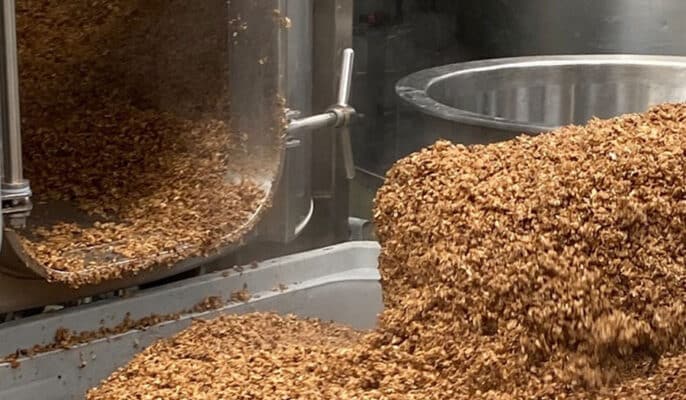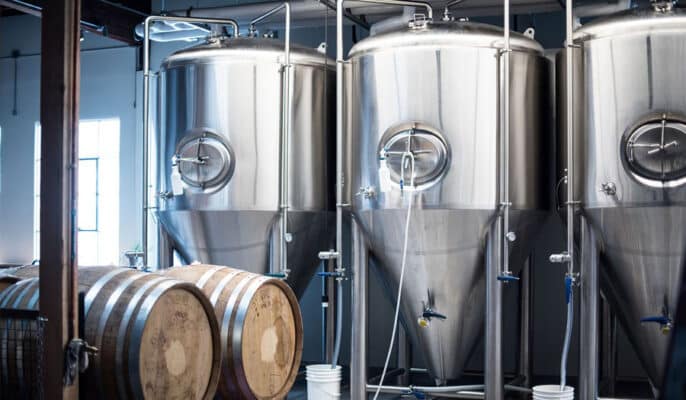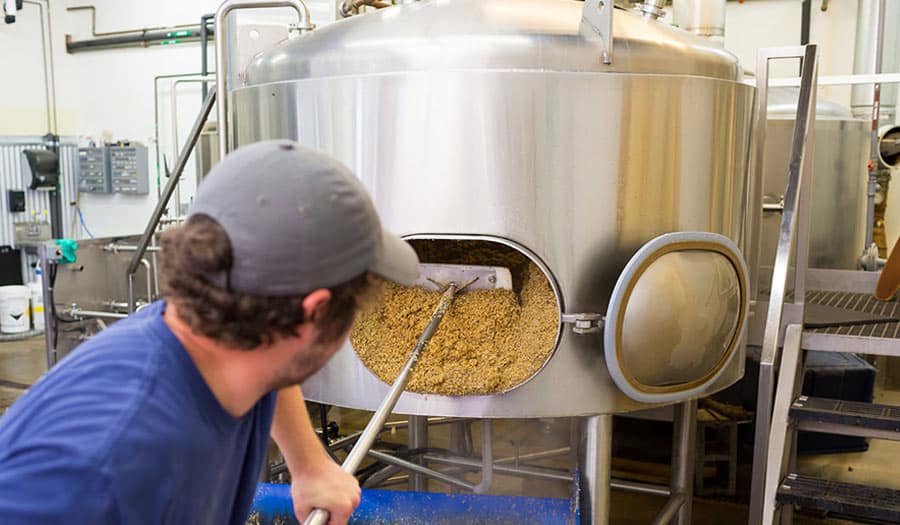ビール醸造と製造のプロセスにおいて、ビール醸造設備の選択と構成は極めて重要である。ビール醸造所では、原料処理から最終製品のパッケージングに至るまで、一連の専門的な醸造設備が必要です。麦芽、もろみ、煮沸、発酵から熟成、パッケージングに至るまで、各装置は生産プロセスで独自の役割を果たし、各ステップは効率的で信頼性の高い醸造装置のサポートと切り離せません。
ビール製造工程
- ほとんどのビールは、穀物、水、ホップ、酵母という4つの基本的な原料から醸造される。醸造の前提は、穀物から糖分を抽出し、酵母が発酵プロセスを通じてアルコールに変換することである。
- 原料の準備:大麦などの穀物を浸漬、発芽、乾燥させて麦芽を作る。この麦芽を粗挽きにして、マッシュ用に仕込む。
- マッシュ:モルトパウダーを湯と混ぜ、加熱し、撹拌してデンプンを発酵可能な糖に変える。麦芽の残渣と糖化した麦汁を分離する。
- 沸騰させる:麦汁を沸点まで加熱し、ホップなどのスパイスを加えて煮沸し、苦味と香りを抽出する。煮沸した麦汁は発酵に適した温度まで急速に冷却する。
- 発酵:冷却された麦汁は一次発酵のために酵母と混合され、酵母は糖分をアルコールと二酸化炭素に変換する。
- 熟成:発酵後のビールをさらに貯蔵・熟成させ、風味を発展させ、味を安定させる。

醸造設備
マルターズ
ビール用に選んだ穀物を粉砕することは、ビール醸造の第一歩です。モルトマシンは、一度に大量の穀物を粉砕できる装置です。その工程には、蒸煮、発芽、乾燥が含まれます。モルトマシンの選択は、最終的なビールの風味と品質に影響します。
膨大な量の穀物を扱うことを考えると、信頼できる機器が必要である。
ブリューケトル
マッシュケトルまたはマッシュポットとしても知られるブリューケトルは、ビール製造において最も重要な機器のひとつです。主な役割は、粉砕した麦芽をお湯と混ぜてマッシュすることです。この工程で、麦芽に含まれるデンプンが発酵可能な糖に変換され、その後の発酵段階に必要な原料が供給されます。
醸造釜は通常、熱伝導性と耐久性に優れたステンレス鋼やその他の耐腐食性材料で作られています。必要な温度を維持するための加熱装置(蒸気加熱や電気加熱など)と、麦芽と水を均一に混合するための攪拌装置を備えています。最近の醸造釜には、温度制御システムや自動制御パネルが装備されている場合もあり、麦芽転換効率とビールの風味の安定性を確保するため、麦芽転換工程中の温度と時間を正確に調整・監視します。
沸騰装置
煮沸装置はビール製造の重要な部分で、潰した麦汁を沸点まで加熱し、そこで重要なホップを加えるために使用します。この煮沸釜で、ビールの最終的な風味が完成する。ボイルポットでの熱と時間は、ビールの色や香りにも影響します。多くのボイルポットにはボルテックスシステムがあり、プロセスを通して液体から固形粒子を取り除き、高温を通して微生物の可能性を排除し、ビールの安全性と安定性を保証します。
発酵タンク
発酵タンクはビール製造において最も重要な設備のひとつである。冷却した麦汁と酵母を混ぜて発酵させるために使用します。発酵タンクの設計は、酵母の活性とビールの風味に影響します。ビールを醸造し、基本的な材料を加えたら、次のステップは発酵タンクに移すことで、ビールのスタイルによってはシングルタンクと呼ばれることもあります。商業的な醸造にはかなりの数の発酵タンクが必要で、発酵タンクは作りたいビールに合わせて大きくする必要があります。ここで酵母を加え、麦汁を本物のビールに変えることができる。発酵タンクは厳密に管理された環境で、酵母が糖分をアルコールに変えるのを助ける。
ブライト・タンク
ブライトタンクは、熟成タンクまたは後発酵タンクとも呼ばれ、ビールの最終熟成と安定化のためにビール製造に使用される重要な設備です。主に、ビールの発酵が完了した後のさらなる熟成、清澄化、炭酸化工程に使用されます。ブライトタンクのデザインと機能は、ビールの最終的な品質、風味、外観に重要な役割を果たします。ブライトタンクは通常、耐食性と耐久性を確保するために高品質のステンレス鋼で作られています。ステンレスは洗浄や消毒も簡単で、ビールの品質が汚染されることはありません。ブライトタンクの形状は、沈殿物の分離やガスの均一な流通を容易にするため、円筒形が主流です。サイズは生産規模によって異なり、小型の実験用タンクから工業用の大型タンクまであります。
充填装置
ケグとボトリングラインは、最終製品のパッケージングと流通に不可欠です。生産効率を向上させながら、ビールを最も新鮮な状態で消費者に届けることを保証します。ビールは容器に正確に注入され、通常、注入量と速度を調整する自動制御システムが装備されています。容器は、ビールが外界から汚染されることなく、鮮度を維持できるように栓がされる。閉栓工程には、ボトルキャップ閉栓、缶シールなどがある。大量生産に適した効率的な充填・キャップシステムで、缶にビールを充填します。
ビール醸造設備の選び方は?
醸造規模
- 自家醸造:家庭で醸造を行う場合は、必要なバッチサイズに適した機器が必要です。通常、初心者には容量が数リットルから数十リットルの小型の醸造器具が適している。
- 業務用醸造:商業的な醸造を計画している場合、設備にはより大きな出力が必要で、数十リットルから数百リットルのシステムが必要になるかもしれない。
醸造設備タイプ
- 全自動と半自動:全自動装置は、工程を簡略化したい人に適している。温度や撹拌などを自動的にコントロールできる。しかし、通常はより高価である。半自動装置は、より多くの手作業を必要とするが、通常はより手頃な価格である。
- バッチ醸造と連続醸造:バッチ醸造は小規模醸造や多品種生産に適している。連続醸造は大規模生産に適しており、生産効率を向上させることができる。
財務予算
- エントリーレベル:醸造を始めたばかりの人は、基本的なボイラー、発酵タンク、温度調節装置などがセットになった手頃なキットを検討しよう。
- 高度なもの:予算が高ければ、ステンレス製の発酵タンクや自動化システムなど、より高度な設備に投資することができる。
醸造設備材料
- ステンレススチール:耐久性に優れ、お手入れが簡単で、ほとんどの醸造器具に使用されています。
- アルミニウム:通常より軽いが、ステンレス鋼ほどの耐久性はない。
- ガラス製:小規模な実験には適しているが、大規模な生産には適さない。
その他の特徴
- 温度制御システム:正確な温度制御は、醸造プロセス、特にイースト発酵にとって非常に重要です。
- 攪拌機:自動攪拌機能を備えた装置もあり、攪拌効果を高めることができる。
- ろ過システム:不純物を取り除き、ビールの品質を向上させます。
アフターサービス
機器に問題が発生したときにタイムリーなサポートを受けられるよう、サプライヤーが提供する保証と修理サービスについて知っておきましょう。
高品質の重要性 ビール醸造設備
効率性と生産性
高品質の醸造機器は、ビールの品質を向上させるだけでなく、醸造プロセス全体の効率を大幅に改善します。先進的なシステムは、パウンディング、ボイリングから発酵、パッケージングに至るまですべてを簡素化し、製造ミスのリスクを低減し、ダウンタイムを削減することで、大量生産をより現実的なものにします。この効率性は、商業醸造所が高い需要に応えながら優れた水準を維持するのに役立ちます。
耐久性と寿命
高品質の醸造設備は耐久性に優れていることが多いため、長期的な視点で投資するのが賢い選択です。最高級の機器には、耐腐食性や耐摩耗性に優れたステンレス鋼のような頑丈な素材が使用されており、酷使に耐えることができます。メンテナンスの必要性や交換頻度が減るため、醸造業者にとっては大幅なコスト削減と高い投資対効果が期待できる。
風味と香りを高める
醸造設備は最終製品の味と香りに直接影響を与えます。高品質の機器は、醸造環境をより正確にコントロールすることができます。例えば、精密な温度制御を備えた酵母発酵槽は、酵母を最適な状態に保ち、望ましい発酵特性を達成するのに役立ちます。同時に、これらの機器は汚染や臭いを効果的に防ぎ、ビールの味をより純粋で洗練されたものにします。
一貫性と品質管理
高品質のビール醸造設備の最も大きな利点の1つは、各バッチのビールの一貫性を保証する能力です。精密に制御されたブリューポット、発酵槽、濾過システムは、特定の温度と条件の一貫性を保証します。この正確な制御は、ビールの味、香り、全体的な品質を維持するために不可欠であり、それによって顧客満足度とブランド評価が高まります。

よくあるご質問
どのような基本的なビール醸造設備が必要ですか?
- ブリューポット:麦芽と水を温めるのに使う。
- 発酵タンク:発酵に使用される容器で、通常はエアロックが付いている。
- 冷却器:沸騰した麦汁を素早く冷ますために使う。
- フィルター:麦芽の残渣を取り除くために使用する。
- 温度コントローラー:酵母が最適な温度で発酵するようにする。
- 瓶詰め設備または樽設備:出来上がったビールを瓶詰めまたは樽詰めするために使用される。
醸造用ポットにはどのような仕様が必要ですか?
醸造用ポットの大きさは、醸造するバッチによって異なる。自家醸造では通常10~50リットルの容量のポットを使用しますが、商業生産ではもっと大きなポットが必要になる場合もあります。
ビールの品質と一貫性を確保するには?
- 洗浄と消毒すべての器具は、感染や汚染を避けるため、使用前と使用後に徹底的に洗浄・消毒しなければならない。
- 温度管理:安定した発酵温度を維持することは、一貫性を保つために不可欠です。優れた温度管理装置に投資することで、各バッチのビールの一貫性を保つことができます。
- 記録と追跡:各醸造のパラメータとプロセスを記録することは、分析と改善に役立つ。
醸造設備の寿命は通常どのくらいですか?
- 家庭用醸造器具:一般的に、手入れが行き届いた家庭用醸造器具は何年も使用できる。
- 業務用機器:業務用醸造機器は通常、より頑丈に設計されており、頻繁な使用に耐え、寿命も長いが、それでも最適な性能を維持するためには定期的なメンテナンスが必要である。




